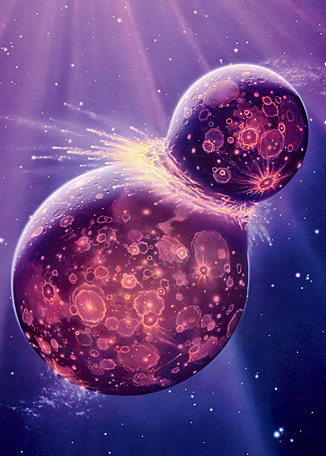
For more than 30 years, scientists have been trying to verify Giant Impact Theory, which posits that the Earth’s moon was created 4.5 billion years ago in an apocalyptic collision between a planetary body called Theia and the early Earth. The smashup released so much energy it melted and vaporized Theia and much of the proto-Earth’s mantle. The Moon then condensed out of the cloud of rock vapor, some of which also re-assimilated into the Earth.
Washington University researchers are now a step closer to proving that hypothesis true.
If Moon’s origins were indeed cataclysmic, there would be important differences in the two bodies’ geochemical composition. A critical but elusive piece of evidence in proving the vaporizing event is isotopic fractionation, which is caused by differences in weight but not in gross chemical properties of two isotopes of an element.
Looking for such fractionation, a group led by Frédéric Moynier, PhD, assistant professor of earth and planetary sciences, analyzed 20 samples of lunar rocks collected from various locations during the Apollo missions, as well as a lunar meteorite. For comparison, they also analyzed 10 Martian meteorites. In doing so, they found the first direct physical evidence to support Giant Impact Theory: the isotopic fractionation of zinc.
Compared with the terrestrial or Martian rocks, the lunar rocks Moynier and his team — which included doctoral student Randal Paniello and colleague James Day of the Scripps Institution of Oceanography — analyzed have much lower concentrations of zinc but are enriched in the heavy isotopes of zinc. “The magnitude of the fractionation we measured in lunar rocks is 10 times larger than what we see in terrestrial and Martian rocks,” Moynier says, “so it’s an important difference.”
The simplest explanation for these differences is that conditions during or after the formation of the Moon led to more extensive volatile loss and isotopic fractionation than was experienced by Earth or Mars. “How do you remove all of the volatiles from a planetary body?” Day asks. “You require some kind of wholesale melting event of the Moon to provide the heat necessary to evaporate the zinc.” An event, in other words, like Theia smashing into Earth.
Comments and respectful dialogue are encouraged, but content will be moderated. Please, no personal attacks, obscenity or profanity, selling of commercial products, or endorsements of political candidates or positions. We reserve the right to remove any inappropriate comments. We also cannot address individual medical concerns or provide medical advice in this forum.